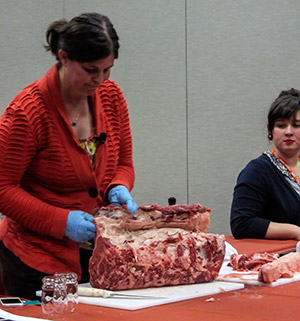CattleWomen Learn New Meat-cutting Methods
SAN ANTONIO, Texas (Feb. 3, 2015) — A $160 ribeye roll from Sam’s Club was the center of attention during a beef-cutting demonstration at an American National CattleWomen Inc. (ANCW) working group session Feb. 3 in San Antonio, Texas. Leading the demonstration and discussion was Jennie Hodgen, a tech service meat scientist with Merck Animal Health.

Jennie Hodgen
Hodgen noted that with carcass sizes getting larger, today’s beef-cutting practices need to be reconsidered to produce an appropriate — and healthy — portion size. She said the Beef Alternative Merchandising (BAM) research offers retail meat cutters, chefs and home chefs several options.
“There’s a perception that beef is bad for you,” Hodgen said, and suggested that by talking about proper portion size the industry can address some of that. She noted that it’s not healthy to eat an 18- to 20-ounce (oz.) ribeye steak when the recommended serving size is 3 oz. As well, she noted that a smaller portion size becomes much more affordable for consumers.
As she trimmed and separated the ribeye roll, when she came to the longissimus dorsi muscle, Hodgen told the “traditionalists” in the audience “close your eyes.” She then proceeded to cut this high-value muscle in half lengthwise.
“This gives you smaller portions and multiple cooking options,” she explained, citing beef medallions, or thin slices for beef appetizers as examples. When cut at a thickness of about 2-1/2 to 3 inches (in.), these pieces can also be butterflied to make larger portioned steaks. Left uncut, it can be prepared like a small prime rib “and be cooked much more quickly,” said Hodgen.
She noted that with the typical cutting method, a ribeye roll produces about 16 large steaks; whereas, cutting it the alternative way that she demonstrated produces about 30 1-in.-thick filet-size steaks.
Hodgen encouraged CattleWomen in attendance to visit with retail managers about the value in cutting smaller portion sizes using the BAM guidelines.
“It’s cheaper for them, easier to cook small portions for the customer, and we get more customers,” she pointed out.
For more about the BAM cutting methods visit http://beefretail.org/bamcuts.aspx or http://beefretail.org/bampos.aspx for recipes.
Editor’s Note: The articles used within this site represent a mixture of copyrights.This article was written by staff or under contract for the Angus Journal. If you would like to reprint or repost this article, you must first request permission of the Angus Journal by contacting the editor at 816-383-5200; 3201 Frederick Ave., Saint Joseph, MO 64506. The Angus Journal claims copyright to this website as presented. We welcome educational venues and cattlemen to link to this site as a service to their audience.

